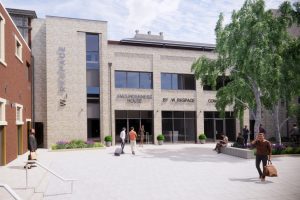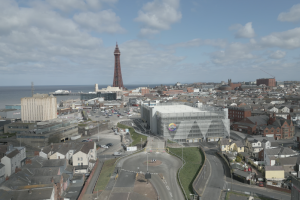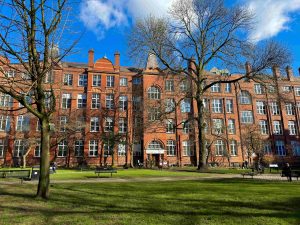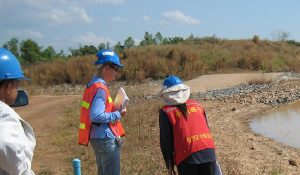Regeneration: Trafford expects more from divvied business rates

TRAFFORD Council’s role as a net contributor of business rates means that the area should receive top billing for investment if Greater Manchester’s councils are granted more control over funds, says leader Matt Colledge.
The coalition government is understood to be considering moves to let local councils keep the money they raise through business rates in a bid to encourage them to grow local business bases. Colledge said that he recognised that Trafford’s role
within AGMA would be as a net contributor to the Greater Manchester core, but added that this should be recognised by the other council leaders when it comes to deciding on where cash should be invested.
“If each borough kept the business rates then virtually every other borough would lose out. We realise the need for these to be equalised,” he said. “But there needs to be a quid pro quo which would ensure that Trafford would be near to the top of the list for transport and other investments so that we can continue to grow the business base.”
Trafford Council is understood to be the 11th-largest net contributor to the business rate pool in the country, raising £155m in business rates but only receiving around £53.9m of redistributed business rates from a total formula grant of £70.5m received from the government.
Moreover, there are plenty of proposed schemes in the area that need investment – not least within Altrincham’s own town centre, which was identified last year as having one of the highest rates of empty shops in the country.
A core strategy document drawn up by Trafford Council’s planners last year, which is still working its way through a lengthy consultation process, identified the town of Carrington as one of five key development priorities over the next 25 years, with the potential to develop 75 hectares of employment land and 1,500 new homes.
Colledge said that the land earmarked for development – much of which is owned by Shell – was “probably one of the most important sites in Greater Manchester” in terms of its potential.
“The owners are very much open to doing something far more productive with that land,” he said.
He added that any proposals for the area will “take a bit of working up”, but said the council was keen to work with Shell to ensure development would feature amenities such as transport, schools and other facilities that would provide sustainable growth – “not just general business parks sat between housing developments”.
He also said that any development should take into consideration the nearby Partington town centre.
“It’s a 15-20-year plan but I am obviously eager to make sure that we get on that journey,” he said.
Another area where he is hoping for progress quickly is the Lancashire County Cricket Club redevelopment, which is set for a High Court hearing next month as a result of an ongoing legal challenge from Albert Gubay’s property company Derwent Holdings.
Colledge argued that the council’s decision had already been upheld with a thorough impact on other local centres such as Stretford and Chorlton accompanying it.
“Any further obstacles serve no purpose whatsoever,” said Colledge. “It’s been on the start block for months and the deadline for the ECB in selecting venues (for the 2013 Ashes series) is approaching,” he said.
“It’s the jewel in the crown in the North West as a cricket venue.”
It also provides an element of what he described as “the beginnings of a very powerful cultural and sporting economy”, stretching from the cricket ground past the nearby football ground and onto Trafford Wharfside linking to the ITV site at MediaCity:UK.
Combined with the huge Mediacity site on the other side of the bank, Colledge said the ITV site used for Coronation Street “provides a terrific anchor for further development”.
He sees Wharfside as providing the potential for “refocusing the edge of Trafford Park, reflecting more modern industries”.
For instance, he said it would be an area which can provide more digital and production space as well as other services such as hotels and leisure facilities that make better use of under-utilised industrial space.
The council recently approved plans by Manchester-based Adam Geoffrey management for Greater Manchester’s biggest hotel – a 775-bed hotel with conference space and a nightclub at the vacant Victoria Warehouse nearby, and Colledge said that such facilities were needed if the area were to sustain inward investment.
He said that Trafford Park remained one of three major engines for the city-region’s economy, alongside the city centre and Manchester airport.
“It’s been very successful but with the right approach we believe we can really step it up a gear for the benefit of the whole area, and Wharfside has its role to play within that plan.”
The nearby Pomona site is one where momentum seems to be lacking, despite its significant potential and its closeness to Salford Quays.
“We’re keen to see development but it needs to be appropriate and 100% commercially viable,” said Colledge. “With the right approach we can turn yesterday’s decay into tomorrow’s future”.
Another area where criticism has been levelled at Trafford Council has been the state of some of the town centres, most notably Altrincham which was identified by the Local Data Company last September as having 29% of its shops as lying empty.
It hasn’t been helped by the fact that a major town centre regeneration scheme, Altair, has stalled and that the Stamford Quarter shopping centre appointed Jones Lang LaSalle as Law of Property Act receivers earlier this year.
Colledge has responded by establishing a body known as Altrincham Forward which has recruited the likes of Bruntwood’s Chris Oglesby, ex-Trafford Park Development Corporation chair Mike Shields and representatives from other developers to come up with a plan to revitalise the area by promoting independent-led shops.
Caroline Baker, a Manchester-based director of DTZ’s consulting team taksed with developing a new long-term plan for the town, said that Altrincham had a wealthy catchment area, but that potential customers were staying away from the town centre.
She added that the town had a history of strong, independent retailers and leisure operators, but that these seemed to have been displaced in recent years.
“There are still strong independents in Wilmslow and Hale, and I’m keen to establish what we need to do to bring them back to Altrincham,” she said.








